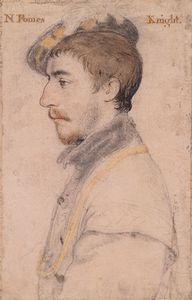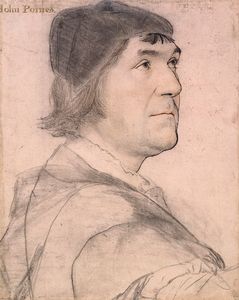| Other Poyntz's |
Sir Nicholas Poyntz, 2nd Baron, had two other sons as well as Hugh: Nicholas Poyntz (yet another Nicholas) went into the church, and became Vicar of Hoo in Kent. The youngest son, Sir John Poyntz succeeded to his mother's estate of Iron Acton, near Tockington on the north side of Bristol. Here are some of the most significant descendants of this John Poyntz.
|
Sir Nicholas Poyntz, of Iron Acton
|
|
John Poyntz
(both drawings by Hans Holbein the younger)
|
Sir Nicholas Poyntz, 2nd Baron, had two other sons as well as Hugh, the 3rd Baron: Nicholas Poyntz (yet another Nicholas) went into the church, and became Vicar of Hoo in Kent. The youngest son, Sir John Poyntz succeeded to his mother's estate of Iron Acton, near Tockington on the north side of Bristol. This line of the Poyntz family, which continues to this day, produced some interesting descendants.
Sir Nicholas Poyntz, of Iron Acton (c1506 - 1557). Sir Nicholas owned Acton Court, the manor of Iron Acton, near Bristol. In 1535, King Henry VIII visited Acton Court, with his new wife Anne Boleyn (who incidentally was a first cousin of a later owner of Sutton Poyntz, Thomas Howard, Viscount of Bindon). Sir Nicholas set about building a complete new wing to Acton Court, furnishing and decorating it lavishly for the King's visit. This is the building that is now seen when you visit Acton Court - little is left of the older medieval manor house.
John Poyntz, food taster to Queen Katherine (c1490 - 1544). John was uncle to the Sir Nicholas just described. John's father, Sir Robert Poyntz, fought for Henry VII at the Battle of Bosworth, and was later Chancellor to Katherine of Aragon. John gained the job of 'sewer' (food taster) to Queen Katherine. The line of the Poyntz family at Acton Court died out in 1680; John Poyntz is the ancestor of the present Poyntz family, and of Sydenham Poyntz, soldier extraordinaire.
Maj-Gen Sydenham Poyntz (1607 - ?). Sydenham Poyntz was born in 1607, to a merchant family living at Reigate in Surrey. In 1625, he ran away, and joined the Dutch army. Over the next 20 years or so, he fought for various armies, apparently changing sides at least once during the Thirty Years War. While fighting for the Imperial Spanish army, he rose to the rank of Major-General. In 1644, he returned to England, in order to join the Parliamentary Army, for whom he led the Northern Association army to a victory at Rowton Heath. He then initiated the siege of Newark, which ended the First Civil War. Poyntz then quarelled with Cromwell over strategy and the politicisation of the New Model Army. He fled the country, only to return in 1647 as a Major-General in the Royalist army. When the Royalists were defeated in the Second Civil War, Poyntz fled the country again, to the West Indies and probably then North America. He never returned to England, and his final fate is not known.


